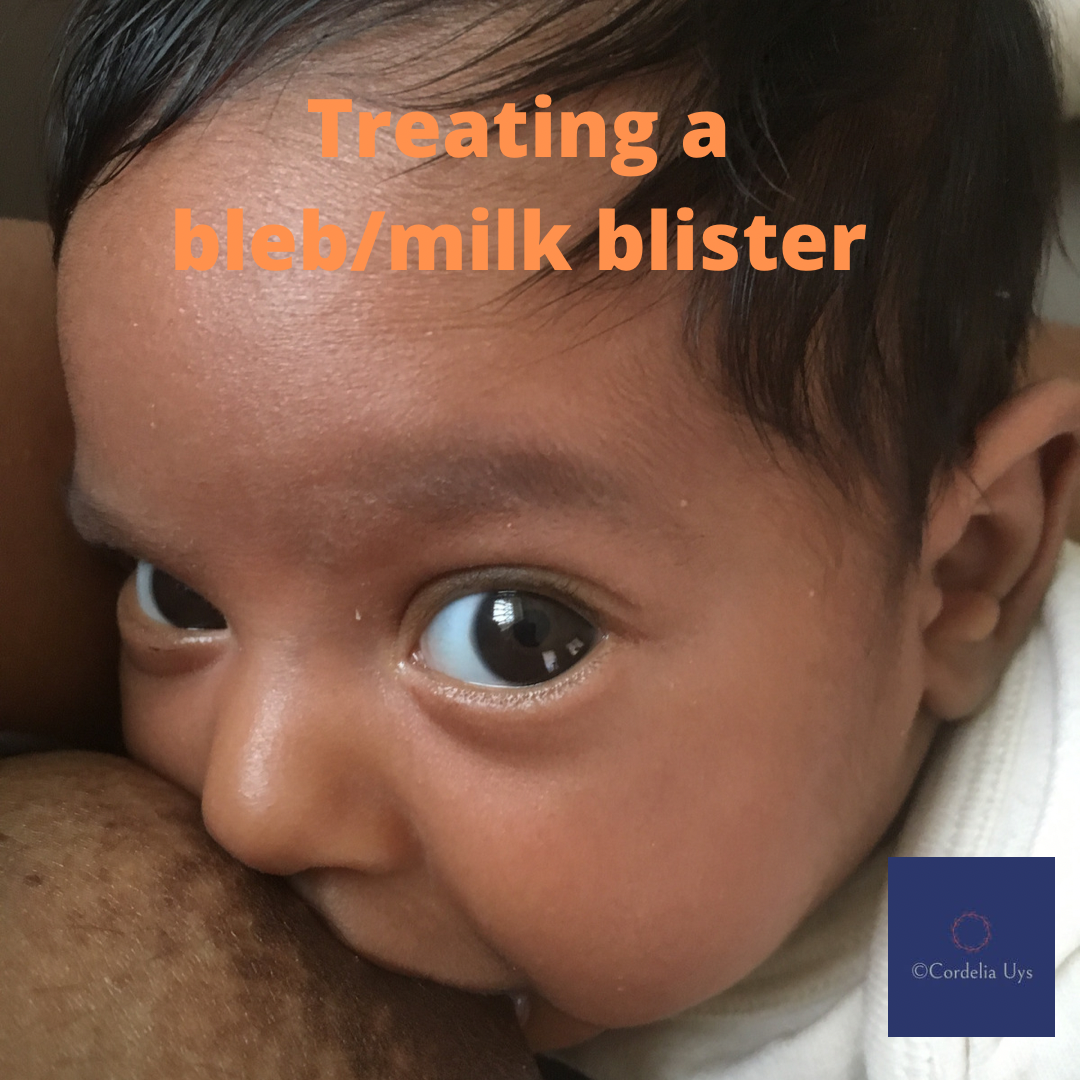Treating a bleb (also known as a milk blister)
By Cordelia Uys, NCT Breastfeeding Counsellor
A bleb, also know as a milk blister, is a white or yellow spot at the tip of a mother’s nipple.
Blebs happen when:
A thin layer of skin grows over one, or more, of the milk duct orifices on the nipple, causing a build up of milk behind.
Or
There is a blockage in the orifice caused by solidified breastmilk.
This results in intense pain in the nipple and just behind it. Blebs are often caused by a baby compressing the nipple repeatedly during feeds, or if a mother is pumping using a breast shield that’s too small.
This is the way an IBCLC Lactation Consultant colleague suggests dealing with a bleb/milk blister:
Choose a time when you can be at home for at least 4 hours.
Every hour, soak the breast with the bleb in a bowl of warm water for a few minutes.
Then take a very clean flannel and rub the bleb gently.
When you’ve done that, either breastfeed your baby, or hand express for several minutes.
Repeat on the hour, four times. You may find that a thread of congealed milk will come out of the bleb.
Lecithin
In general, if you suffer from blebs, taking lecithin is a good idea, as is putting a cotton wool ball soaked in olive oil over your nipple inside your bra, to soften the bleb between feed.
http://kellymom.com/nutrition/vitamins/lecithin/
Ultrasound
It is also possible to have ultrasound treatment to clear blebs: https://www.cordeliauys.co.uk/therapeutic-ultrasound
Do not attempt to pierce or lift the skin over the bleb yourself
Several sources recommend using a sterile needle to pull away the skin on top of the bleb. However, it is difficult to make conditions completely sterile at home, and I would strongly advise against trying to do it yourself, as it’s very easy to cause an infection. You might be able to find a nurse or lactation consultant who will do it for you.
Tiffany: ‘I had lots of blebs until I took lethicin. I used to use a sterile needle to lift the bleb away and the blockage would clear immediately. However, this once caused an infection which was nasty. You could go to a nurse and ask them to do it for you under true sterile conditions.’
Katie: ‘I also popped my bleb as I couldn’t shift. I was pleased as punch for 48 hours before I developed a HORRIFIC infection which resulted in pus coming from the duct. Next time I got one, I followed the advice above, it took about a week to fully shift, but was fine thereafter. I had about 4 Epsom salt baths a day (told my husband they were medicinal!) and they really helped too.’
Katrina B. Mitchell, an American breast surgeon and IBCLC Lactation Consultant says the following
Massage of the breast and manipulation of blebs causes bleeding and worsened tissue swelling. She believes pumping, particularly with an incorrectly fitting breastshield or with the vacuum set too high, increases the likelihood of getting blebs.
She is adamant that unroofing blebs with needles promotes more inflammation and can result in permanent scarring.
If you have a bleb that has caused milk obstruction in your breast, she recommends:
Alternate applying heat and cold.
Take paracetamol and ibuprofen.
Seek therapeutic ultrasound.
Ask your GP for a light steroid cream.
And take sunflower lecithin regularly.
Dr Thomas Hale: " Topical application to the nipple is generally approved by most authorities if amounts applied and duration of use is minimized. Only small amounts should be applied and then only after feeding; larger quantities should be removed prior to breastfeeding. 0.5% to 1% ointments rather than cream are generally preferred.”
Another source https://www.sps.nhs.uk/articles/safety-in-lactation-topical-corticosteroids/ recommends cream rather than ointment, so it probably doesn’t matter too much which is used.
Katrina B. Mitchell says the cream or ointment should be applied ‘several times a day.’
from Katrina B. Mitchell’s paper: https://www.nccwebsite.org/content/documents/courses/Breast%20conditions%20during%20lactation.pdf


